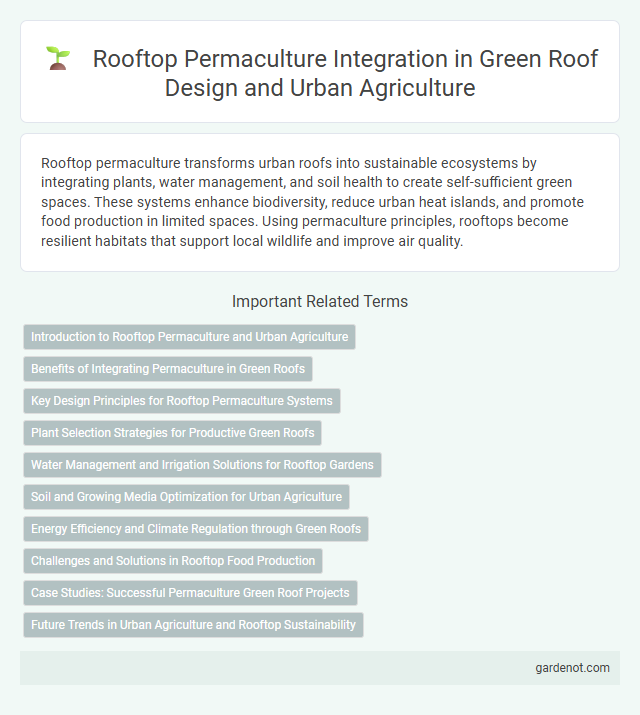Rooftop permaculture transforms urban roofs into sustainable ecosystems by integrating plants, water management, and soil health to create self-sufficient green spaces. These systems enhance biodiversity, reduce urban heat islands, and promote food production in limited spaces. Using permaculture principles, rooftops become resilient habitats that support local wildlife and improve air quality.
Introduction to Rooftop Permaculture and Urban Agriculture
Rooftop permaculture integrates sustainable agricultural practices into urban environments by transforming rooftops into productive green spaces that support local food production and biodiversity. Urban agriculture on rooftops reduces the urban heat island effect, improves air quality, and promotes food security by providing fresh, organic produce directly within city limits. This approach utilizes permaculture principles such as water conservation, soil regeneration, and plant diversity to create resilient ecosystems that enhance environmental and social wellbeing in densely populated areas.
Benefits of Integrating Permaculture in Green Roofs
Integrating permaculture principles in green roofs maximizes biodiversity by creating layered ecosystems that support diverse plant and animal species, improving urban resilience. This approach enhances stormwater management by naturally filtering and retaining rainwater, reducing runoff and lowering urban heat island effects through increased evapotranspiration. Permaculture-designed green roofs also boost food security by enabling urban agriculture, providing fresh produce while reducing transportation emissions and fostering community engagement.
Key Design Principles for Rooftop Permaculture Systems
Rooftop permaculture systems emphasize maximizing biodiversity, water conservation, and soil health to create resilient urban ecosystems. Key design principles include utilizing native plants adapted to rooftop microclimates, implementing rainwater harvesting techniques to reduce runoff, and layering vegetation to optimize space and promote ecological interactions. Strategic placement of plant guilds and incorporation of renewable energy support sustainable productivity and energy efficiency in rooftop environments.
Plant Selection Strategies for Productive Green Roofs
Choosing drought-tolerant and native plant species enhances water efficiency and resilience in rooftop permaculture systems. Incorporating a mix of deep-rooted perennials and shallow-rooted herbs optimizes soil health and nutrient cycling, boosting overall productivity. Seasonal plant diversity supports pollinators and improves yield stability for sustainable green roofs.
Water Management and Irrigation Solutions for Rooftop Gardens
Rooftop permaculture integrates water management systems such as rainwater harvesting and greywater recycling to sustainably nourish green roofs while minimizing runoff and conserving potable water. Drip irrigation and smart moisture sensors optimize water distribution, reducing waste and promoting healthy plant growth in rooftop gardens. Incorporating permeable substrates and water-retentive layers further enhances irrigation efficiency and supports resilient rooftop ecosystems.
Soil and Growing Media Optimization for Urban Agriculture
Optimizing soil and growing media in rooftop permaculture is crucial for enhancing plant health and maximizing crop yields in urban agriculture. Utilizing lightweight, nutrient-rich substrates with high water retention and aeration capabilities supports root development and microbial activity while reducing structural load on rooftop systems. Incorporating organic matter, biochar, and tailored amendments ensures sustained fertility and resilience against urban environmental stresses, promoting sustainable green roof agriculture.
Energy Efficiency and Climate Regulation through Green Roofs
Rooftop permaculture integrates diverse vegetation layers that enhance green roofs' ability to regulate urban microclimates by reducing heat island effects and improving air quality. The strategic planting of drought-resistant plants and native species optimizes thermal insulation, lowering energy consumption for cooling and heating in buildings. Green roofs also play a critical role in managing stormwater runoff, contributing to sustainable urban water cycles and mitigating climate change impacts.
Challenges and Solutions in Rooftop Food Production
Rooftop permaculture faces challenges such as limited soil depth, weight restrictions, and exposure to harsh weather conditions, which impact plant growth and sustainability. Solutions include using lightweight, nutrient-rich substrates, implementing modular raised beds to optimize space, and incorporating windbreaks or shade structures to protect crops. Efficient water management systems like drip irrigation and rainwater harvesting enhance resource use and improve crop yields on urban rooftops.
Case Studies: Successful Permaculture Green Roof Projects
Rooftop permaculture projects such as the Bullitt Center in Seattle and the ACROS Fukuoka building in Japan demonstrate the viability of integrating edible plants, rainwater harvesting, and biodiversity on urban rooftops. These case studies highlight permaculture principles like soil regeneration, microclimate creation, and efficient resource cycling to maximize productivity and ecological benefits. Data from these projects indicate significant reductions in urban heat island effect and increased local food production.
Future Trends in Urban Agriculture and Rooftop Sustainability
Rooftop permaculture integrates sustainable practices such as rainwater harvesting, vertical gardening, and composting to enhance urban agriculture productivity while reducing environmental impact. Emerging technologies like IoT sensors and AI-driven systems optimize water usage, soil health, and crop yields on green roofs, promoting resilient and self-sustaining ecosystems. Future trends emphasize multi-functional rooftop spaces that support biodiversity, renewable energy generation, and local food production, advancing urban sustainability goals and climate resilience.
Rooftop permaculture Infographic

 gardenot.com
gardenot.com